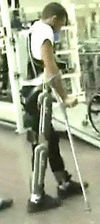Safety and tolerance of the ReWalk™ exoskeleton suit for ambulation by people with complete spinal cord injury: a pilot study
- PMID: 22333043
- PMCID: PMC3304563
- DOI: 10.1179/2045772312Y.0000000003
Safety and tolerance of the ReWalk™ exoskeleton suit for ambulation by people with complete spinal cord injury: a pilot study
Abstract
Objectives: The objective of the study was to evaluate the safety and tolerance of use of the ReWalk™ exoskeleton ambulation system in people with spinal cord injury. Measures of functional ambulation were also assessed and correlated to neurological spinal cord level, age, and duration since injury.
Study design: Case series observational study.
Setting: A national spinal cord injury centre.
Methods: Six volunteer participants were recruited from the follow-up outpatient clinic. Safety was assessed with regard to falls, status of the skin, status of the spine and joints, blood pressure, pulse, and electrocardiography (ECG). Pain and fatigue were graded by the participants using a visual analogue scale pre- and post-training. Participants completed a 10-statement questionnaire regarding safety, comfort, and secondary medical effects. After being able to walk 100 m, timed up and go, distance walked in 6 minutes and 10-m timed walk were measured.
Results: There were no adverse safety events. Use of the system was generally well tolerated, with no increase in pain and a moderate level of fatigue after use. Individuals with lower level of spinal cord injury performed walking more efficiently.
Conclusion: Volunteer participants were able to ambulate with the ReWalk™ for a distance of 100 m, with no adverse effects during the course of an average of 13-14 training sessions. The participants were generally positive regarding the use of the system.
Figures
References
-
- Winchester PK, Carollo JJ, Parekh RN, Lutz LM, Aston JW., Jr. A comparison of paraplegic gait performance using two types of reciprocating gait orthoses. Prosthet Orthot Int 1993;17(2):101–6 - PubMed
-
- Stallard J, Major RE. A review of reciprocal walking systems for paraplegic patients: factors affecting choice and economic justification. Prosthet Orthot Int 1998;22(3):240–7 - PubMed
-
- Kobetic CS, To JR, Schnellenberger ML, Audu TC, Bulea R, Gaudio G, et al. Development of hybrid orthosis for standing, walking, and stair climbing after spinal cord injury. J Rehabil Res Dev 2009;46(3):447–62 - PubMed
-
- Colombo G, Joerg M, Schreier R, Dietz V. Treadmill training of paraplegic patients using a robotic orthosis. J Rehabil Res Dev 2000;37(6):693–700 - PubMed
-
- Banala S, Kim S, Agrawal SK, Scholz JP. Robot assisted gait training with active leg exoskeleton (ALEX). IEEE Trans Neural Syst Rehabil Eng 2009;17(1):2–8 - PubMed
MeSH terms
LinkOut - more resources
Full Text Sources
Other Literature Sources
Medical



